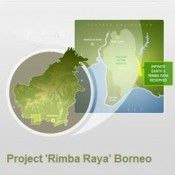Perseverance Pays Off For
Massive Indonesian REDD Project
Five years in the making, the Rimba Raya Biodiversity Reserve Project has overcome seemingly insurmountable political challenges to become one of the largest-ever REDD projects to see its emission reductions verified under the Verified Carbon Standard by proving that it reduced greenhouse gas emissions by more than two million tons in one year – and may reduce nearly 120 million by the time it finishes.

4 June 2013 | Two years ago, Indonesia’s Rimba Raya Biodiversity Reserve was on the rocks after the country’s Ministry of Forestry turned more than half of its 80,000 hectares over to palm oil interests – an act that prevented it from becoming the first carbon project to generate credits under the Verified Carbon Standard (VCS) for saving endangered rainforest and reducing greenhouse gas emissions from deforestation and forest degradation (REDD). By the end of last year, however, the project had been saved – reportedly after intervention by powerful forest friends like Singapore-based businessman Rusmin Widjaja, Central Kalimantan Governor A. Teras Narang, and several green-minded wives of high-ranking officials. VCS then signed off on its design, and all that remained was for an independent auditor to make sure that the design was, in fact, being implemented and the promised emission-reductions were, in fact, taking place.
Last week, independent auditor SCS Global Services confirmed that the project had, in fact, prevented the emission of roughly 2.2 million tons of carbon dioxide into the atmosphere over the year ending in July, 2010, meaning it can now sell 2,181,352 Verified Carbon Units (VCUs) from that period. Over the course of its 30-year life, the project aims to reduce emissions by 119 million tons.
Located in the state of Central Kalimantan, it covers almost 64,000 hectares and aims to preserve carbon-rich tropical peat swamp and forest, originally slated for development into palm oil plantations, while also providing a critical reserve for endangered Orangutans.
“The Rimba Raya project has undergone a lengthy and complex review process,” said Dr. Robert J. Hrubes , SCS Executive Vice President. “The scale of this project is truly precedent setting, demonstrating a strong market value in preserving forests.”
The region has suffered from high rates of deforestation and is home to over 94 threatened and endangered species, including the Bornean Orangutan. Orangutan Foundation International, operated by renowned primatologist and conservationist Dr.Birute Mary Galdikas , is the NGO Partner and Project Beneficiary for the project. The sale of carbon credits will fund the preservation of critical Orangutan habitat.
“Rimba Raya will be one of the most important Orangutan conservation projects in the world, said Galdikas. “It is nothing less than the promise of survival for the endangered Orangutan.”
“We are exhausted but overjoyed to have earned verification for the Rimba Raya project,” said Todd Lemons , CEO of InfiniteEARTH, the project developer. “While this project has faced monumental hurdles, SCS’ experience assessing REDD projects proved invaluable for fairly evaluating our compliance with the VCS standard and verifying that these emissions reductions are as real and valuable as we believe they are.”
The project also meets the requirements of the Climate, Community and Biodiversity Alliance (CCBA) standard by supporting the livelihoods of local communities and the area’s rich biodiversity. It was the first in the world to earn Triple Gold Validation under the CCBA standard.
Additional resources
Please see our Reprint Guidelines for details on republishing our articles.

